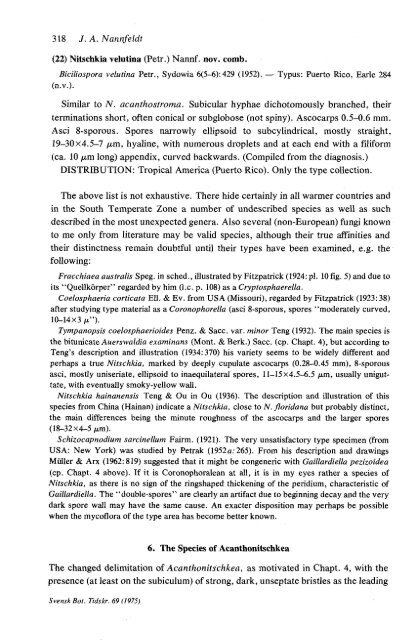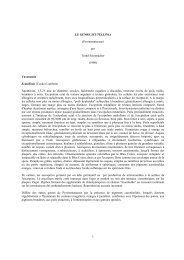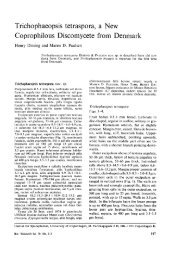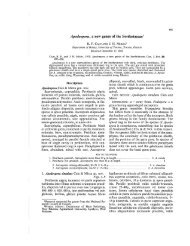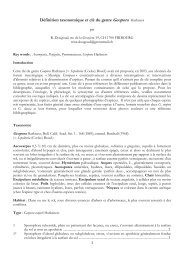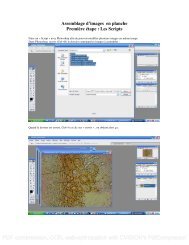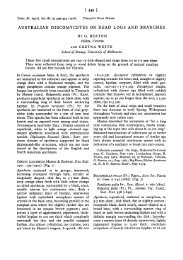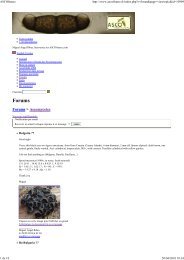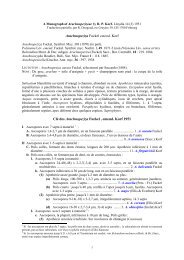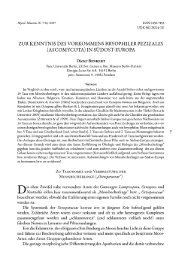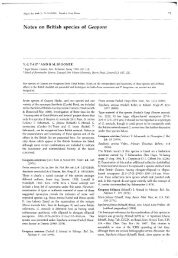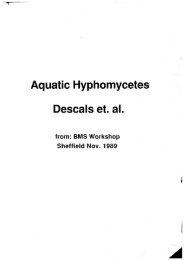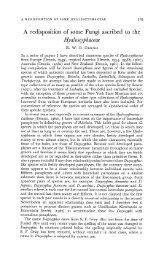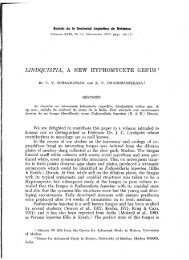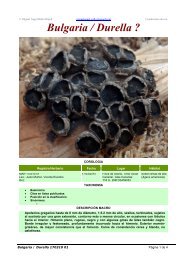Stray Studies in the Coronophorales (Pyrenomycetes) 4-8 - ASCOfrance
Stray Studies in the Coronophorales (Pyrenomycetes) 4-8 - ASCOfrance
Stray Studies in the Coronophorales (Pyrenomycetes) 4-8 - ASCOfrance
Create successful ePaper yourself
Turn your PDF publications into a flip-book with our unique Google optimized e-Paper software.
318 J. A. Nannfeldt(22) Nitschkia velut<strong>in</strong>a (Petr.) Nannf. nov. comb.Biciliospora velut<strong>in</strong>a Petr., Sydowia 6(5-6):429 (1952). — Typus: Puerto Rico, Earle 284(n.v.).Similar to N. acanthostroma.Subicular hyphae dichotomously branched, <strong>the</strong>irterm<strong>in</strong>ations short, often conical or subglobose (not sp<strong>in</strong>y). Ascocarps 0.5-0.6 mm.Asci 8-sporous. Spores narrowly ellipsoid to subcyl<strong>in</strong>drical, mostly straight,19-30x4.5-7 ¡xm, hyal<strong>in</strong>e, with numerous droplets and at each end with a filiform(ca. 10 ftm long) appendix, curved backwards. (Compiled from <strong>the</strong> diagnosis.)DISTRIBUTION: Tropical America (Puerto Rico). Only <strong>the</strong> type collection.The above list is not exhaustive. There hide certa<strong>in</strong>ly <strong>in</strong> all warmer countries and<strong>in</strong> <strong>the</strong> South Temperate Zone a number of undescribed species as well as suchdescribed <strong>in</strong> <strong>the</strong> most unexpected genera. Also several (non-European) fungi knownto me only from literature may be valid species, although <strong>the</strong>ir true aff<strong>in</strong>ities and<strong>the</strong>ir dist<strong>in</strong>ctness rema<strong>in</strong> doubtful until <strong>the</strong>ir types have been exam<strong>in</strong>ed, e.g. <strong>the</strong>follow<strong>in</strong>g:Fracchiaea australis Speg. <strong>in</strong> sched., illustrated by Fitzpatrick (1924: pi. 10 fig. 5) and due toits "Quellkorper" regarded by him (I.e. p. 108) as a Cryptosphaerella.Coelosphaeria corticata Ell. & Ev. from USA (Missouri), regarded by Fitzpatrick (1923:38)after study<strong>in</strong>g type material as a Coronophorella (asci 8-sporous, spores "moderately curved,10-14x3 ft").Tympanopsis coelosphaerioides Penz. & Sacc. var. m<strong>in</strong>or Teng (1932). The ma<strong>in</strong> species is<strong>the</strong> bitunicate Auerswaldia exam<strong>in</strong>ans (Mont. & Berk.) Sacc. (cp. Chapt. 4), but accord<strong>in</strong>g toTeng's description and illustration (1934:370) his variety seems to be widely different andperhaps a true Nitschkia, marked by deeply cupulate ascocarps (0.28-0.45 mm), 8-sporousasci, mostly uniseriate, ellipsoid to <strong>in</strong>aequilateral spores, 11-15x4.5-6.5 pm, usually uniguttate,with eventually smoky-yellow wall.Nitschkia ha<strong>in</strong>anensis Teng & Ou <strong>in</strong> Ou (1936). The description and illustration of thisspecies from Ch<strong>in</strong>a (Ha<strong>in</strong>an) <strong>in</strong>dicate a Nitschkia, close to N. floridana but probably dist<strong>in</strong>ct,<strong>the</strong> ma<strong>in</strong> differences be<strong>in</strong>g <strong>the</strong> m<strong>in</strong>ute roughness of <strong>the</strong> ascocarps and <strong>the</strong> larger spores(18-32x4-5 ixm).Schizocapnodium sarc<strong>in</strong>ellum Fairm. (1921). The very unsatisfactory type specimen (fromUSA: New York) was studied by Petrak (1952a:265). From his description and draw<strong>in</strong>gsMiiller & Arx (1962:819) suggested that it might be congeneric with Gaillardiella pezizoidea(cp. Chapt. 4 above). If it is Coronophoralean at all, it is <strong>in</strong> my eyes ra<strong>the</strong>r a species ofNitschkia, as <strong>the</strong>re is no sign of <strong>the</strong> r<strong>in</strong>gshaped thicken<strong>in</strong>g of <strong>the</strong> peridium, characteristic ofGaillardiella. The "double-spores" are clearly an artifact due to beg<strong>in</strong>n<strong>in</strong>g decay and <strong>the</strong> verydark spore wall may have <strong>the</strong> same cause. An exacter disposition may perhaps be possiblewhen <strong>the</strong> mycoflora of <strong>the</strong> type area has become better known.6. The Species of AcanthonitschkeaThe changed delimitation of Acanthonitschkea, as motivated <strong>in</strong> Chapt. 4, with <strong>the</strong>presence (at least on <strong>the</strong> subiculum) of strong, dark, unseptate bristles as <strong>the</strong> lead<strong>in</strong>gSvensk Bot. Tidskr. 69 (1975)


